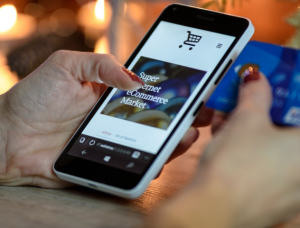The rise of digital technologies has transformed myriad industries, none more so than retail. In recent years, the luxury sector has experienced a significant shift toward eCommerce, raising questions about its viability and future in this increasingly digital marketplace. Is there a market for luxury eCommerce in the digital age? Recent trends, consumer behavior, and market data provide a compelling narrative that suggests not only is there a market, but it is also thriving in innovative and unexpected ways.

The Luxury Market Overview
Before diving into the specifics of luxury eCommerce, it’s essential to understand the broader landscape of the luxury market. The global personal luxury goods market experienced a resurgence post-pandemic, with a staggering valuation of $300 billion in 2022, according to Bain & Company. The market is projected to grow by 5% to 10% annually in the upcoming years, signifying a robust demand for luxury products despite economic fluctuations.
Historically, luxury brands relied heavily on physical retail spaces—opulent stores on high streets or in upscale shopping malls—but the digital revolution has transformed consumer shopping habits, prompting brands to pivot online. As noted in a report by McKinsey, 30% of luxury purchases now occur online, a figure that is only expected to increase.
The Shift to Digital: A Necessary Transition
Luxury brands have traditionally been hesitant to embrace eCommerce, worried that online sales could dilute their prestigious image. However, the global pandemic served as a catalyst, forcing many traditional retailers to establish or enhance their online presence. A study by Shopify showed that 75% of consumers tried new shopping behaviors during the pandemic, with many of those practices persisting long after lockdowns ended.
Take, for example, Gucci. The brand reported that more than 30% of its sales now come from online channels. This shift is mirrored across the luxury eCommerce landscape, with major players like Louis Vuitton, Chanel, and Prada ramping up investments in digital technology and online platforms.
Consumer Demographics and Behavior
The Millennial and Gen Z Influence
A driving force behind the growth of luxury eCommerce is the influence of younger generations. According to a report from Bain & Company, over 70% of luxury purchases in 2025 will be made by millennials and Gen Z consumers. These demographics are not just comfortable shopping online; they actively prefer it.
Platforms such as Instagram and TikTok have become essential tools for luxury brands seeking to connect with younger audiences. These platforms provide a curated glimpse into luxury lifestyles, allowing brands to showcase products through influencers and aspirational marketing that resonate with digital natives. This social media influence is backed by data showing that 70% of Gen Z consumers regularly purchase items based on social media recommendations.
Sustainability and Ethical Consumption
Today’s luxury consumers are also increasingly mindful of sustainability and ethical production practices. A 2021 study by Deloitte indicated that 66% of millennials are willing to pay more for sustainable products. This trend has prompted luxury brands to adopt more transparent and eco-conscious practices, influencing their eCommerce strategies. For instance, brands like Stella McCartney and Burberry now emphasize their commitment to sustainability in their online platforms, appealing to ethically-minded consumers.
The Role of Technology in Luxury eCommerce
Augmented Reality (AR) and Virtual Reality (VR)
As luxury brands navigate the digital landscape, technology plays a crucial role in enhancing the customer experience. Augmented Reality (AR) and Virtual Reality (VR) technologies are increasingly being integrated into luxury eCommerce strategies. Brands like Dior and Gucci have utilized AR to allow customers to virtually try on products, restoring some of the tactile elements lost in an online environment.
It is reported that AR can increase conversion rates by up to 80%. This statistic illustrates the potential of immersive technologies to create a more engaging digital shopping experience that can rival the in-person experience.
Personalized Shopping Experiences
Artificial intelligence (AI) is another tool reshaping the luxury eCommerce sector. Brands that leverage AI can analyze customer data to provide personalized shopping experiences, enhancing user engagement and satisfaction. A study by McKinsey found that personalization can deliver five to eight times the ROI on marketing spend and increase sales by 10% or more.
By utilizing data analytics and AI-driven recommendations, luxury brands can curate selections tailored to individual tastes, making the online shopping experience more appealing and relevant to each consumer.
The Challenges Ahead
Despite the promising outlook for luxury eCommerce, several challenges remain. One of the most significant hurdles is maintaining brand exclusivity in a digital space. With the internet’s expansive reach, luxury brands must be cautious about overexposure and over-saturation. Strategic marketing and limited online releases can help mitigate this risk.
Additionally, logistics and distribution pose challenges for luxury eCommerce. Ensuring that products are delivered on time while maintaining the luxury experience (think packaging, delivery services) requires meticulous planning and investment.
According to a report by UPS, over 70% of consumers consider the delivery experience as influential in their overall perception of a brand, especially for luxury goods. Therefore, luxury brands must invest in logistics solutions that align with their brand image, which can be a considerable expense.
The Future of Luxury eCommerce
Looking ahead, the future of luxury eCommerce appears promising. As brands continue to innovate and adapt to digital trends, several key areas will likely shape the landscape:
- Omnichannel Strategies: Successful luxury brands will likely adopt omnichannel approaches that seamlessly integrate online and offline experiences. This strategy allows brands to maintain an exclusive in-store shopping environment while providing the convenience of online purchasing.
- Sustainability Initiatives: As consumer preferences evolve, brands that prioritize sustainability may gain a competitive edge. Transparency in sourcing and production will become crucial for luxury brands looking to attract conscientious consumers.
- Emerging Technologies: Continued advancements in technology, particularly AR/VR and AI, will create new opportunities for immersive shopping experiences. Brands that invest in these technologies can enhance customer engagement and foster loyalty.
- Global Expansion: As eCommerce continues to grow in emerging markets, luxury brands will have opportunities to reach new consumers. Asia, particularly China, remains a significant market for luxury goods, with eCommerce projected to grow rapidly in the region.
Wrap Up
The evidence is clear: there is a vibrant and growing market for luxury eCommerce in the digital age. As consumer preferences shift and technology continues to reshape retail landscapes, luxury brands must adapt to thrive. By embracing eCommerce, focusing on personalized experiences, and investing in sustainability, luxury brands can not only survive but flourish in this dynamic marketplace.
As we look to the future, the blending of luxury with digital capabilities presents an exciting frontier for both businesses and consumers. Luxury eCommerce is not just a trend—it’s a fundamental evolution in how luxury goods are marketed, sold, and experienced, signaling a new era for the industry that embraces both exclusivity and accessibility.
Embracing Alternatives: TrueGether as a Rising Star in Luxury eCommerce
As the luxury eCommerce landscape continues to evolve, platforms dedicated to enhancing the seller experience are crucial to this transformation. TrueGether emerges as a standout alternative for those looking to increase their online sales without the burden of excessive fees. This innovative platform powers over 10,000 businesses, enabling them to reach millions of shoppers through AI-empowered campaigns.
Easy and Fee-Free Selling
One of the most appealing aspects of TrueGether is its user-friendly interface, which makes it easy for sellers to manage, promote, and grow their businesses online. Without any listing, monthly, or transaction fees, sellers retain 100% of their sales profits. This no-cost model stands in stark contrast to many traditional eCommerce platforms, which often impose hidden fees and commissions that can eat into earnings.
TrueGether’s fee-free structure allows sellers to offer competitive pricing, making their products more attractive to consumers. Established since 2012, TrueGether has proven that a no-fee policy can empower sellers to thrive while successfully driving sales. Its promise of no hidden charges is a refreshing approach that has resonated with many users.
A Seamless Selling Experience

For those wondering how they can start selling on TrueGether, the process is streamlined. Sellers simply need to register for an account and add their products, either individually or through bulk uploads. Once products are listed, TrueGether takes care of the rest, optimizing listings and managing advertising campaigns across organic and paid channels. Sellers can then sit back and relax, knowing that TrueGether is working to maximize their online visibility and return on investment.
With over 20,000 product categories, sellers can offer a diverse range of goods, from luxury apparel and electronics to unique home décor. TrueGether’s advanced features ensure that sellers can effectively connect with potential buyers, enhancing their sales potential in the burgeoning world of eCommerce.
Seller Success Stories
The platform has garnered numerous positive testimonials from satisfied sellers. Many report that TrueGether has simplified their selling processes and improved their profitability. One seller remarked, “TrueGether has made selling easy with its easy-to-use platform. The most exciting thing is that I started seeing the results immediately!” This sentiment reflects a growing trend among online merchants seeking platforms that prioritize seller success.
Other sellers have pointed out the advantages of choosing TrueGether over competing platforms. Another user shared, “Besides TrueGether, we also sell on other selling alternatives, but we give full marks to TrueGether in terms of the margin we’re able to make.” Such testimonials highlight how TrueGether is paving the way for businesses to harness the digital marketplace, particularly in the luxury segment.
Commitment to Seller Empowerment
TrueGether’s dedication to seller support is evident in its array of resources and training programs designed to empower users. Their team of experts is available to assist sellers, ensuring they have the necessary knowledge and tools to maximize their online sales. This focus on education illustrates TrueGether’s commitment to creating a supportive community of sellers.
As traditional retail experiences decline, platforms like TrueGether represent a promising future for luxury eCommerce. By providing an intuitive, user-friendly platform that eliminates excessive fees and offers unparalleled support, TrueGether is establishing itself as one of the best alternatives to traditional eCommerce giants such as eBay.
In summary, TrueGether stands out not just as an eBay alternative but as a leader in fostering a more equitable environment for sellers in the luxury eCommerce space. Its no-fee structure and emphasis on AI-driven campaigns make it an attractive option for those seeking to expand their online presence while keeping their earnings intact. With a market ripe for innovation, sellers looking to navigate the digital landscape successfully may find their best partner in TrueGether.